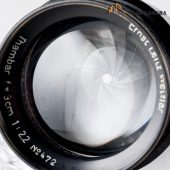A few weeks ago I received a tip about a new Leica THAMBAR-M 90mm f/2.2 lens but I did not report it on the blog because it came from a new source and I wanted to get at least one more confirmation before publishing online. I usually never report on “unconfirmed” rumors coming from unknown sources or questionable websites. A few days ago I even mentioned the exact same lens here in the comments section of LeicaRumors:

The Japanese site Nokishita just confirmed today that in addition to the Noctilux-M 75mm f/1.25 ASPH, Leica will announce also a new Thambar-M 90mm f/2.2 lens:
- Leica NOCTILUX-M 75mm f/1.25 ASPH lens: late 2017 announcement (was initially scheduled for April)
- Leica THAMBAR-M 90mm f/2.2 lens: to be released in the first half of 2018
The new lens will be a re-edition of the famous Leitz Thambar 9cm f:2.2 of the late 1930s, a portrait lens with adjustable blur – see this eBay listing for pictures:
Here is some additional information on the original Thambar lens:
The screwmount 90 f2.2 Thambar enjoyed a production run from 1935-49 during which less than 3000 were made. Specially designed for portraiture, the accompanying, original filter with its silvered center spot, is used to create soft focus effects. This showpiece collectible is absolutely striking. Features: dual aperture scales for use with (red) and without (white) filter Supplied with the original lens hood. (KEH)
But one Leica 90mm seems to keep us sleepless even it was made in 1935 to 1940, and only in 3,000 samples. It’s the Leica 90mm Tahmbar f/2.0 which was made as a deliberately soft-focus lens. It even came with a Soft Focus filter that would blur the center of the image; so as to assure that everything was blurred! (Overgaard)
Check also the specs of the original version (mir):
- Marketed: 1935~1949
- Focal Length: 9cm (90mm)
- Mount: LEICA SM
- Min. Focusing Distance: approx. 1m (3ft)
- Minimum / Maximum Aperture: f/25~f/2.2
- Filter Attachament Size: E48
- Weight: approx. 520g
The optical diagram of the historical Thambar is a simplified version of that of the Hektor:




























